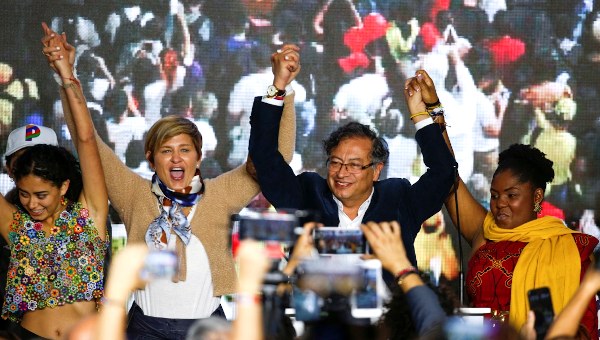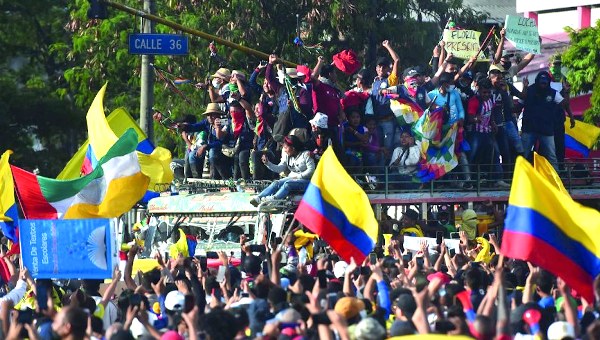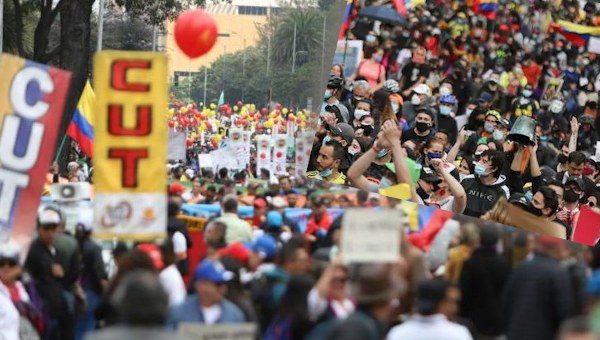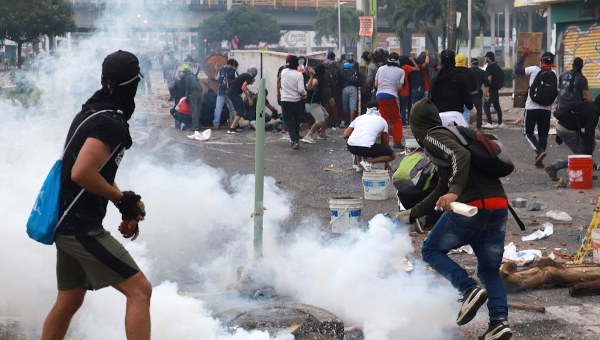Colombia: The Military, Peasants, and the Environment
Colombia witnessed a series of mass protests at the end of April following a call for a national strike. Still ongoing, the protests have many causes: an apparent “tax reform” that was going to transfer even more wealth to the 1 percent in Colombia; the failure of the most recent peace accords; and the inability of Colombia’s privatized health care system to contain the COVID-19 crisis. In response to these ongoing protests, the government has killed dozens, disappeared hundreds, imposed curfews on multiple cities, and called in the army. But the protests continue – because they are, at least in part, a repudiation of the militarization of everything in the country.
In the background of the uprising in Colombia is the question of land. A multi-decade civil war has led to millions of peasants being thrown off of their land, which ended up in the hands of large landowners or was used for corporate megaprojects. In the ongoing corporate land grab that has been taking place in Colombia for the last few years, there is a new and frightening weapon: the militarization of environmental conservation. In a countrywide series of military operations beginning in February, involving a large number of soldiers and police, the army captured 40 people, whom the attorney general accused of deforestation and illegal mining, in six different locations in the country. In an earlier operation, the army captured four people for crimes against the environment, who have been labeled as “dissidents of the guerrillas of the Revolutionary Armed Forces of Colombia (FARC)” by Colombia’s President Iván Duque, according to an article in Mongabay. In another operation in March 2020, soldiers trying to capture illegal ranchers in national parks picked up 20 people, 16 of whom turned out to be peasants who did not own land or cattle, according to Mongabay. According to the Colombian military, eight operations were carried out in 2020, through which it had “recovered more than 9,000 hectares of forest,” while capturing 68 people, 20 of whom were minors, stated the article in Mongabay.
What the military calls “recovered” forest is a territory emptied of its people. The overall initiative, which began in 2019, is labeled “Operation Artemis.” It deploys what one article in the City Paper (Bogotá) calls “Colombia’s full-metal eco-warriors” in an effort to reduce deforestation by 50 percent, as President Duque told Reuters.
With so much military defense of the forest taking place, several questions arise: Is deforestation a problem that can be solved with the use of weapons? Can the forest be saved through mass arrests? Can the same military that killed thousands of innocent people, including peasants, in an attempt to inflate their body count statistics, be trusted to protect the environment?
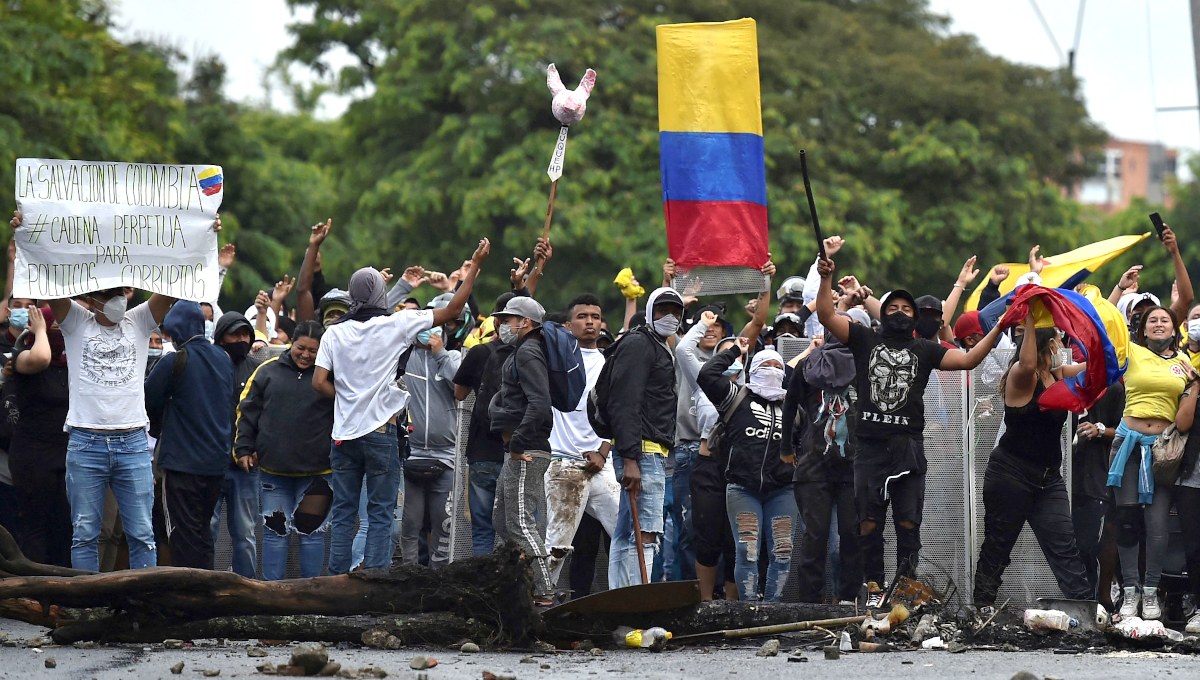
The Amazon Threatened
The deforestation of the Amazon is a real problem. The Colombian Amazon comprises about 42 percent of Colombia’s land area and 6 percent of the total area of the Amazon, with Bolivia and Venezuela each making up another 6 percent, Peru 9 percent, and Brazil 66 percent of the total Amazon area.
President Jair Bolsonaro of Brazil campaigned on the promise to “develop” the Amazon and has taken rapid steps toward doing so. In Colombia too, deforestation has taken place rapidly, at a rate of between about 100,000 and 200,000 hectares per year as of 2018. The biggest motors of deforestation are ranching, burning, cultivation of coca and poppy, and road and mining expansion. If the “recovery” rate – which is defined as clearing people out of the area by military force – follows 2020’s pattern of 9,000 hectares in a year, the army’s “full-metal eco-warriors” are working at least 11 times too slow to stop deforestation. This raises questions about what is really happening in Colombia and why.
The Amazon is protected under the Colombian constitution, as are the territorial rights of Indigenous peoples. Among these rights is the right to free, prior, and informed consent in the event of any development scheme. A number of forums exist through which Indigenous people are theoretically able to exercise these rights. These include the mesa permanente, the comisión nacional and the Mesa Regional Amazónica. A very important portion of the Colombian Amazon – more than half – is, by law, under Indigenous jurisdiction.
These lands are coveted by corporate interests.
Investor Rights Challenged in Courts
The most powerful tool of the corporate land grab makes no pretense of protecting the environment: it is the framework of “free trade,” enshrined in international agreements, which noted linguist and philosopher Noam Chomsky has argued would be better termed as “investor rights agreements.” But this framework is always under challenge by Indigenous people and by courts that have even a modicum of independence.
There are many examples of when Indigenous people have taken to court to uphold their rights over their land. When Canadian mining company Cosigo Resources Ltd. was discovered carrying out illegal activities in an Amazon national park and was investigated by Colombia’s Constitutional Court, the company took Colombia to arbitration in Texas, where the matter is to be conducted as per the United Nations Commission on International Trade Law (UNCITL) rules. Cosigo Resources Ltd. claimed that the Colombian constitutional protections in the Yaigojé-Apaporis National Natural Park violate Colombia’s obligations to protect investor rights under the US-Colombia Trade Promotion Agreement. That battle is ongoing.
Another Canadian mining company, Auxico Resources, is trying to extract the gold and coltan (a key ingredient in cell phones) under the Amazon. Auxico Resources signed a Memorandum of Understanding with the governor of Guainía, Javier Zapata, for the “production of minerals,” according to Minería Pan-Americana. In 2018, Zapata announced that 80 percent of the land had been conceded to Auxico Resources. Zapata is now in prison for corruption. But Auxico is still working in the area. In 2019, President Duque announced the creation of the new municipality of Barrancominas in Guainía, pre-empting an initiative by Indigenous communities (85 percent of the people in Guainía are Indigenous) in the region to establish their land rights.
A third company, Amerisur Resources (now GeoPark), won a license to conduct petroleum exploration in Siona Indigenous territory in Putumayo in southern Colombia (on its borders with Ecuador and Peru), a community of 2,600 people who have been under attack by paramilitaries and narcotraffickers for decades – police records show 23 separate massacres in Putumayo between 1993 and 2014. The community swore in 2014 not to allow petroleum exploitation in their territory. In 2018, the Inter-American Commission on Human Rights “ordered precautionary measures to protect” the Siona, and a Colombian judge also declared that this “sent a clear message” and ordered that Amerisur Resources cease their project of oil exploration there, according to an article in El Espectador. The judge ordered a suspension of licenses for exploration in one of the reserves. Amerisur Resources quickly announced that it would continue mining because “prior consultation,” a right under Colombia’s constitution, had apparently been completed. The battle continues to this day, with the company continuing to insist that it had fulfilled the constitutional requirement for prior consent sometime in the past.
In 2010 in Ecuador, the military proposed creating an army-controlled “protected” forest on Siona territory – the Siona refused. In July 2020, Siona Governor Sandro Piaguaje announced to GeoPark that “[Y]ou are going to lose, because you will not be able to get a drop of oil from our territory.” But now deforestation alerts are popping up all over Siona land along with reports of narcotrafficking. The Siona fear that these alerts will provide a pretext for the military to enter the zone and will start a process that will culminate in handing over the territory to GeoPark.
When discussing corporate interests in the Amazon, the case of Steven Donziger and Chevron in Ecuador shouldn’t be forgotten. In 1993, Donziger took on a historic claim against oil giant Chevron, which had polluted the Amazon in Ecuador and devastated the Indigenous communities there. In 2011, a court in Ecuador ordered that Chevron pay $9.5-billion in damages. Chevron didn’t pay – and then proceeded to use the US court system to persecute Donziger, who is currently living in his second year of house arrest in New York.
Environmental Bubbles Deployed Against Peasants
However high the cost of court battles, Indigenous people have proven that their struggle inside and outside the courts to protect the environment can often succeed. To land-hungry corporations, militarized conservation has emerged as a strategic alternative to risky court battles. Along with Operation Artemis, Colombia has rolled out a strategy of “Environmental Bubbles,” which started in 2016. In 2017, the Colombian military participated in a series of military exercises in the Amazon called “Operation United America,” jointly with the governments of Peru, Brazil, Canada, Panama, Argentina and, of course, the United States – but not Bolivia (then-president Evo Morales refused).
The Environmental Bubbles are surprise operations, which are made public knowledge after the military has carried out an operation to protect some area against illegal activity. Each state (department) in Colombia gets a “rapid reaction force to carry out monitoring, prevention, control and surveillance tasks against the causes of deforestation.”
In 2018, campesino (peasant) organizations testified before the #JuicioALaDeforestación (deforestation trial) tribunal about what the authorities have done to them in the name of conservation. In the La Paya National Natural Park, a peasant delegate from the Leguízamo Peasant Workers Association while reporting on the “alleged abuses against the civilian population by the authorities in the areas” said, “All their belongings, houses and animals were burned during the intervention.” He continued, “We peasants are not the reason for deforestation. The big landowner, who seized one thousand hectares from the park, is walking around freely with no trouble.” Four other military operations of the same type were conducted throughout 2018-19.
The case of Labarce, in the Colombian department of Sucre, is also instructive. Afro-Colombians, some of whose families had arrived in the area as early as 1916, saw their lands become part of a national park – the Santuario de Flora y Fauna el Corchal – in 2002. Their territories suddenly became “terra nullius,” (empty lands) – the same doctrine used to usurp Indigenous people from their lands throughout the Americas, including the United States and Canada where mining corporations are headquartered. The peasants came forward in good faith to cooperate with the process and had rights under the law. In their decades living there, they had protected the biodiversity of the area and maintained a circumscribed territory without expanding further into the forest. All the same, they were classified as illegal occupants of their own land. There are many other cases of peasants being suddenly declared interlopers, generations after their ancestors were encouraged to “colonize” lands.
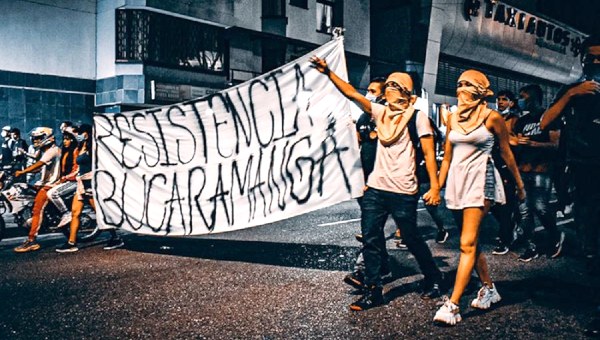
Environmentalism Must Be Demilitarized
The takeover of conservation by military forces is not unique to Colombia – Kenyan scholar Mordecai Ogada has written about the same dynamics in many countries in Africa. He writes on his website, “A foreigner’s love for our wildlife is usually a measure of their hatred for Indigenous people.” If “conservation” can be appropriated as a slogan for displacing Indigenous people, it is time to rethink the concept. It is time to discard Malthusianism, the fantasy of “empty lands,” and the apocalypticism that underlies too much environmental thinking.
The Amazon is estimated to be 13,000 years old, and the region has been inhabited for 19,000 years or more – there is a reason, in other words, to consider the possibility that the wildest rainforest imaginable is in fact a cultural landscape co-created by human beings and other species working together. In the book 1491: New Revelations of the Americas Before Columbus, author Charles Mann gives several estimates as to what fraction of the Amazon was created by Indigenous people; one cautious estimate is that “about 12 percent of the nonflooded Amazon forest was of anthropogenic origin – directly or indirectly created by human beings”; another researcher tells him “it’s all human-created”; and according to another researcher, “The phrase ‘built environment… applies to most, if not all, Neotropical landscapes.”
With the authority of the National Natural Parks of Colombia being used to displace peasants, one proposal for a breakthrough in this conflict is the “Parques con Campesinos” (Parks with Peasants) concept – which would make peasants partners in conservation, rather than setting them up as enemies of the environment.
The greatest weapon against deforestation is no weapon at all. It is to give peasants security of land tenure, to resume the sustainable practices that have preserved the vast and glorious Amazon. The current National Development Plan under Operation Artemis purporting to serve “conservation” goals would see it reduced to a set of disconnected protected areas, cut by roads, surrounded by petroleum blocs, hydroelectric dams, fumigated zones, and mines, as maps presented by the activists at the Amazon Forest Protection Program show. The presence of communities and caretakers on the land – not “full-metal eco-warriors” – is the only reliable way to stop deforestation.
The way to save the planet is not to have the world’s most destructive institution – the modern military – create “bubbles” empty of humans, only to then reassign that land to oil and mineral companies. The way to save the planet is to give the land back to the people whose practices assured the astounding biodiversity we have enjoyed for millennia. •
This article was produced by Globetrotter.


